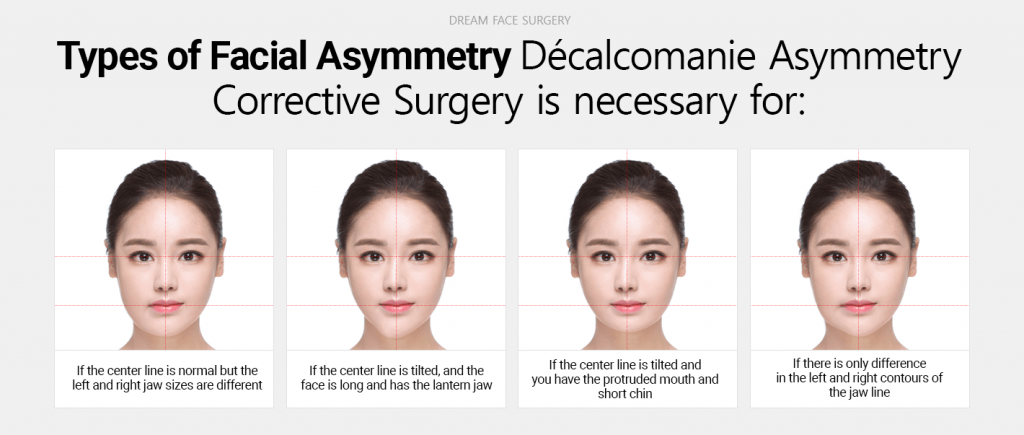
Facial Asymmetry Correction

Procedure Time
2 – 4 Hours

Anaesthesia
General Anaesthesia

Recovery Period
14 – 18 Days

Stitch Removal
7 Days Post-op
What Is Facial Asymmetry?
Facial asymmetry correction can be used realign the face and correct functional aspects such as biting issues.
Facial asymmetry can be identified by drawing a central line through the middle of the face. Where facial asymmetry is present, we can see that the jaw line looks different on the left and right side. Every individual’s face is slightly asymmetrical. However, asymmetry issue that are more obvious may result in aesthetics, psychological or even functional concerns.
In some cases, individuals may experience mouth protrusion, medically known as prognathism, which overlaps with facial asymmetry. As such, facial asymmetry correction can be useful to realign the face.
When Is Facial Asymmetry Correction Needed?
People often look for face asymmetry surgery for one of these reasons:
Aesthetic Reasons: The balance of the facial line and jaw line are broken by facial asymmetry, causing an aesthetic defect in the face.
Psychological Reasons: It is common to see a reduction in self-esteem and other psychological consequences associated to facial asymmetry.
Functional Reasons: Facial asymmetry can cause a dysfunction in the temporomandibular joint, pain or discomfort when chewing or biting, as well as digestive issues.
Type Of Facial Asymmetry Concerns
These are some of the concerns Facial Asymmetry Corrective Surgery can address.

Who Is Suitable For Facial Asymmetry Corrective Surgery?
- A centre line that is not correctly aligned with the upper and lower lip.
- A centre line that is not correctly aligned with the upper and lower teeth.
- A misalignment between the upper teeth and the middle area of the nose.
- A noticeable difference between the chin line in the left and right side.
- A misalignment of the lips when closing or opening the mouth.
Facial Asymmetry Corrective Surgery Methods
There are different approaches for a face asymmetry surgery. Our surgeon will recommend one or a combination of techniques depending on each case, and whether it is only an aesthetic concern or it does involve a functional problem.
We can summarize facial asymmetry correction techniques in two main approaches:
1. In cases of facial asymmetry with a normal occlusion function of the mandible
In these cases, the upper and lower teeth meet nicely together and there are no issues with chewing or other functional movements. The problem is usually caused by an overgrowth or undergrowth of the jaw in a given direction or an uneven development of the cheekbone (zygomas). Facial contouring is enough to solve this particular concern. In some cases, facial asymmetry also involves a bent nose, in which case it is appropriate to consider a corrective rhinoplasty.

2. In cases of severe facial asymmetry with an unbalanced jawbone
In these cases, the lower jaw and the upper jaw are not appropriately balanced. To correct the problem, the surgeon can preposition the upper and lower jaw (osteotomy or a bimaxillary osteotomy). Bimaxillary osteotomy is performed to move the jaw back to a more functional position, allowing for aesthetic and functional improvements at the same time.

Frequently Asked Questions (FAQ) about Facial Asymmetry Surgery
Fixing Facial Asymmetry Seems Complicated. Where Should I Start?
Patients need a significant amount of preparation before they can undergo facial contouring surgery. Proper communication with the surgeon is also important for achieving the desired results. Before performing the procedure, the surgeon will do a thorough examination of your facial soft tissues and bones to assess the best way to achieve the aesthetic goals you have in your mind.
During your preoperative planning sessions ahead of a facial contouring surgery, your surgeon might have discussions with you about:
- The expectations you may have and the results you want to achieve
- Any pre-existing medical conditions, previous cosmetic or medical treatments or surgeries, and drug allergies
- Medications, herbal supplements, or vitamins you may be taking already – some herbal supplements and medications that can worsen bleeding and should not be used after the procedure
- The anatomy of your face, the soft tissue distribution and procedures to improve facial symmetry
- Anaesthesia that best suits you
It is also possible that they ask you to have:
- Blood tests and other necessary pre-surgery screening
- CT scans or Facial X-rays
What To Expect After Facial Asymmetrical Surgery?
Patients usually get a complete list of instructions from their surgeon that offer support throughout their healing process and must be followed strictly. The following points are generally included in the post-operative instructions.
- For the first couple of weeks after the procedure, keep the head in an elevated position while asleep
- Follow instructions to take medications prescribed, especially antibiotics because they play an important part in avoiding an infection
- Apply a cold compress on the site of surgery to subside swelling
- Make sure the bandages around your head are dry and clean
- If you’re given a support garment or bandage, make sure that you keep using it regularly as long as possible while following the directions precisely. It applies gentle compression to subside swelling
- In case of oral incisions, the regular use of an antibacterial gargle or mouthwash is recommended to keep the site clean, as an infection is most likely to happen in the mouth
- In the first week following the surgery, use a liquid diet. Transition to a soft diet for the next 2-3 weeks and make sure you consume lots of nutritious foods like soft vegetables, hummus, soups, pureed fruit, and yoghurts
- Do not perform strenuous exercise or physical activity for a month
- Try to move around after the surgery as soon as possible by taking light walks around the house. It encourages blood circulation which improves the healing process.
- Have follow-up appointments with the surgeon so that they can assess your recovery progress.
When Can I Expect To See The Final Results From My Surgery?
Generally, facial contouring surgery produces permanent results. Visible improvements can be seen after the procedure, but swelling can take around 6 months to subside completely before your face settles into the new shape.
Do I Need To Be Hospitalized After The Surgery?
A Facial Asymmetry Surgery is generally a day surgery procedure which means that the patients don’t need to get hospitalized after the surgery. They can return home the same day after undergoing the procedure. It is advised, however, that somebody should be there to take care of them, at least, for the first 2-3 days after surgery if they are staying alone. For complex cases, your surgeon may recommend you to be hospitalized for 1-2 days. This differs from one case to another.
